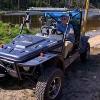TECHNICAL ARTICLES IN THIS FORUM
-
Similar Topics
-
By CRV
I’m need a couple parts. Diff. Lock Actuator mainly. But I would like to find a donor that maybe has bad motor or something along those lines.
if anyone has or knows of anything please holler at me
thanks Randy
-
By Rick A
I charged the battery reconnected everything but utv will not start and nothing comes on when key is turned. such as headlights, dash lights nothing.
-
By Alien10
I have a Coleman Outfitter 550 purchased in January 2022 that runs and operates pretty well. 65 hours on it so far. It is a work vehicle for my 10 hilly acres with two 1 acre woods and 5 acres of "lawn". The rest is under a lake.
My parking brake does not seem to have any grip. It worked when new but after a month or so, it is just almost useless. I press the parking brake pedal hard until it stops. Still, it won't hold even on slight inclines. I don't see the caliper move as I press the brake pedal down. There seems to be plenty of pad left on it and the rotor is shiny as if it is rubbing a little when applied, but not enough to stop it from rolling.
Any thoughts on possible causes?
-
-
By Kingfish
The conversion took about 350lbs. off the vehicle. It never rode great, but now I feel every crack in the road. I have backed off spring compression nut to the point just under where they would move around if suspension was at full extension, but it is still very stiff. I would like to put some softer coilover springs on it, but I have no idea what the spring rate is with the original springs so I would just be guessing on what to order. Does anyone have the data for the original spring compression rate? I am willing to give up a little ground clearance for a softer ride. Right now when sitting still the rear suspension is at or near full extension and the rear tires have several degrees of camber which will cause uneven wear if allowed to continue in this state.
-







Recommended Posts
Join the conversation
You can post now and register later. If you have an account, sign in now to post with your account.
Note: Your post will require moderator approval before it will be visible.